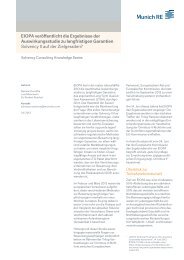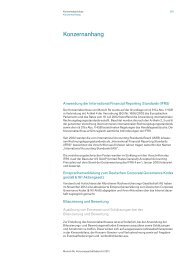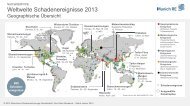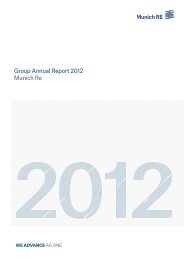Munich Re Group Annual Report 2006 (PDF, 1.8
Munich Re Group Annual Report 2006 (PDF, 1.8
Munich Re Group Annual Report 2006 (PDF, 1.8
You also want an ePaper? Increase the reach of your titles
YUMPU automatically turns print PDFs into web optimized ePapers that Google loves.
<strong>Munich</strong> <strong>Re</strong> <strong>Group</strong> <strong>Annual</strong> <strong>Re</strong>port <strong>2006</strong> Management report_Parameters<br />
Parameters<br />
General parameters<br />
Our business environment is marked to an increasing<br />
extent by growing complexity – together with an upward<br />
trend in natural catastrophes. There has also been a disproportionate<br />
rise in man-made losses in relation to economic<br />
activity. The reasons are many and varied, ranging<br />
from technological progress and the advancing geopolitical<br />
interdependencies to climate change and trends in<br />
international liability. In addition, concentrations of values<br />
are mushrooming and regions are becoming more<br />
dependent on each other, giving rise to new risk potentials<br />
and accumulation hazards. These phenomena present<br />
demanding challenges for the insurance industry, but also<br />
opportunities. It is therefore imperative to carry on refining<br />
risk models and to swiftly incorporate new findings.<br />
Fundamental changes are also resulting from unprecedented<br />
demographic trends. People are living longer –<br />
good news, but also an enormous strain on social security<br />
systems. By 2030, every two people in Europe in paid work<br />
will have to finance one person who is not. This means<br />
Europeans can only maintain their standard of living and<br />
high-quality healthcare in the medium term if they make<br />
additional private provision – a great opportunity for insurers.<br />
Many countries are in the process of realigning their<br />
social security systems to these demographic requirements,<br />
and so for the time being insurers will have to cope<br />
with an uncertain legal and political climate. Speed and<br />
flexibility in product design are becoming increasingly<br />
important competitive factors. At the same time, primary<br />
insurers are having to adjust to the growing group of older<br />
people with special needs.<br />
At present, one of the most important issues for private<br />
health insurance in Germany is the debate regarding<br />
the recently adopted health reform legislation. The German<br />
health reform will not solve the problems of the compulsory<br />
health insurance scheme – so private health insurance,<br />
which is demography-resistant and provides guaranteed<br />
benefits, remains the only alternative to statutory<br />
health insurance.<br />
In addition, the insurance industry’s regulatory environment<br />
is being affected by profound changes. The introduction of<br />
Solvency II in Europe and new accounting standards have<br />
implications for insurers’ capital requirements and income<br />
statements. The new circumstances will have considerable<br />
implications for primary insurers’ business models. They<br />
will also influence the demand for reinsurance cover and<br />
trigger changes in its supply. A group like <strong>Munich</strong> <strong>Re</strong>,<br />
among the leaders in integrated risk management, can<br />
utilise the changing industry dynamics to its advantage<br />
and exploit the business opportunities they present – in<br />
both reinsurance and primary insurance.<br />
Economic parameters<br />
The general global economic environment for the insurance<br />
industry remained largely favourable in <strong>2006</strong>. In spite<br />
of continued strong rises in oil prices until August, the<br />
global economy expanded further, even achieving a<br />
slightly higher growth rate than in the previous year. The<br />
stock markets in Europe and the USA showed respectable<br />
price gains, whereas the upward trend in Japan was somewhat<br />
less pronounced. Yields on the bond markets rose<br />
appreciably in the first half of the year before receding<br />
again until early December, when interest rates reversed<br />
again, rising considerably more steeply in Europe than in<br />
the USA. Overall, the difference between the transatlantic<br />
yields for long-term bonds narrowed over the course of the<br />
year.<br />
Economy<br />
Global economic growth gathered pace slightly in <strong>2006</strong>,<br />
sustaining its momentum. China and the USA are still the<br />
most important engines driving the world economy, even<br />
if the trend in the second half of the year saw economic<br />
dynamics shifting from the USA to the eurozone.<br />
In the USA, the world’s largest insurance market,<br />
momentum remained at about the level of the previous<br />
year on average, despite growth slowing considerably<br />
between July and December, for which a slackening of the<br />
housing market was chiefly responsible. The mainstays of<br />
the US economy were private consumption and corporate<br />
investments, with real GDP rising by 3.3% compared with<br />
the previous year.<br />
61

















